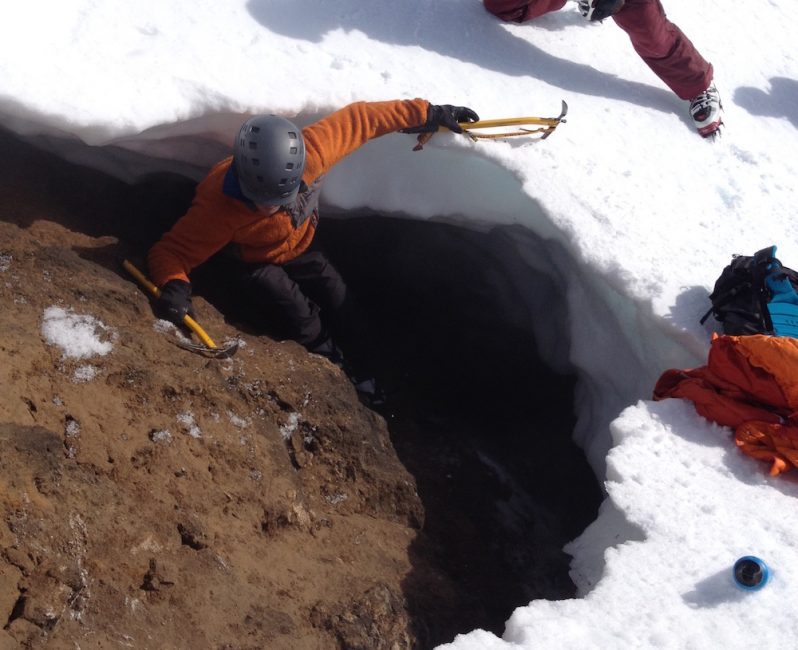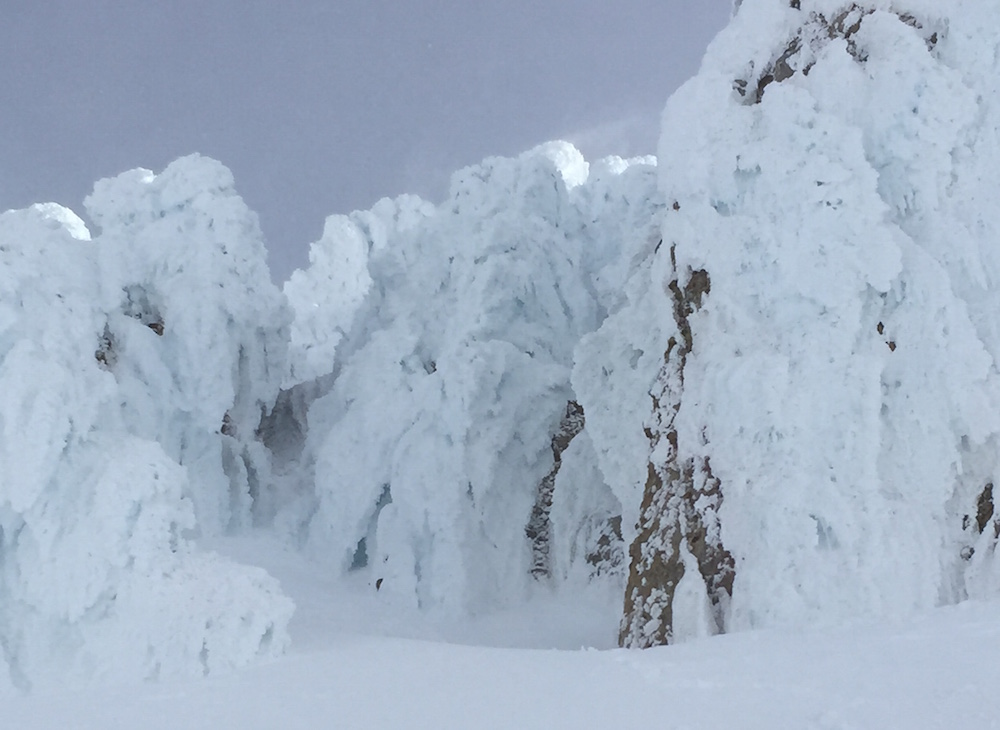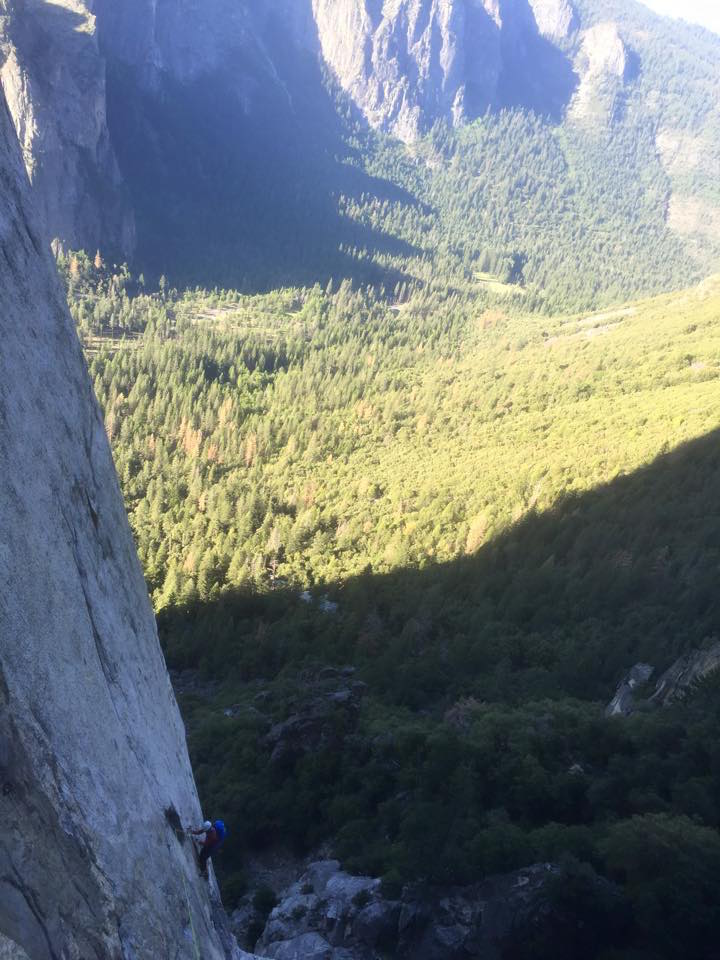The peak of the Mt. Hood climbing season is here, and conditions have been stellar. But anyone heading up for the summit this spring should be fully aware of the risks posed by falling rocks and ice, large crowds of fellow climbers, and several ominously positioned fumaroles containing toxic volcanic gases.
The low snow year at Mt. Hood ski resorts has not ruined the climbing season at all. Far from it. Parties of climbers and ski mountaineers have been enjoying upper mountain terrain for months, because a lot of the precipitation that fell as rain down below fell as snow up above, and less snow on the lower mountain made for easier access. Some upper mountain snow has melted, but it has also been replenished by some timely April snowstorms.
“The conditions are excellent for climbing right now,” says veteran rescue climber Erik Broms. “We’re getting late spring snow which keeps the top of the mountain frozen, and the temperatures have been fairly cool. The amount of snow higher up on the mountain seems to be a little bit below normal, but not by much.”
But Broms knows first-hand that prime climbing time brings inherent risks. He was climbing down from the summit on a beautiful day January 31 when two climbers roped together came plummeting down the mountain, right at him. He managed to dodge them and rushed down to help, and while he was assisting them with other volunteers from Portland Mountain Rescue, he watched as a third climber tumbled down and fell right into a fumarole.
PMR was able to rescue all three climbers that day, but the experience reinforced Broms’s awareness of the risks presented by a highly accessible and popular mountain that also happens to be a live volcano, with some serious pitch to it up high, weather that can change in a matter of minutes, and some very hazardous gases below the snow. Mount Hood is the second most frequently climbed major peak in the world behind Mt. Fuji in Japan. It is also an active volcano.
‘That would be a bad day’
Anyone who has ventured up high on Mount Hood is familiar with the pervasive rotten-egg smell of hydrogen sulfide. The fumaroles by Devil’s Kitchen and the Hot Rocks, vents that release the volcano’s steam, are nothing new. What is new is the location of their melted openings – directly downhill from several popular climbing routes.
“If you fall in the Old Chute, the natural fall line can take you right down to one of those fumaroles,” says Broms.
Fellow rescue climber Dave Clarke, a retired firefighter and diehard telemark skier who also volunteers with PMR, agrees. “The fumaroles are opening up closer to the bottom of the chutes,” he says. “If somebody did take a long fall that is probably where they will end up.”
In addition to the fumarole straight downhill from the Old Chute (one of the most popular climbing routes on the south side of Mt. Hood), Clarke is also concerned about a big opening down by Devil’s Kitchen to the east of the Hogsback. “When you’re skiing down from above it sneaks up on you,” says Clarke. “I could see somebody coming down in low-visibility conditions and ending up in that. That would be a bad day.”
After performing two fumarole rescues over the past year, PMR volunteers have been testing the air inside the fumaroles using a new $3,000 monitor. They have found intermittently high levels of hydrogen sulfide inside several fumaroles, and their research has convinced them to develop a new protocol for fumarole rescues, and to beef up training specific to fumaroles.
Clarke says the readings have been sporadic depending on wind and other factors, but they have found levels of hydrogen sulfide considered hazardous to human health several times. “It can change by the hour or by the spot,” he says. “All these dangers are invisible, and by the time you are feeling the effects of the toxic gas it’s too late.”
New Protocols, New Training
PMR spokesman Mark Morford says the verification of hazardous air inside fumaroles has convinced PMR to develop new protocols and to train volunteers to deal with the specific hazards of fumaroles.
The new protocols hold that PMR first responders will bring their electronic monitor and test the air inside the fumarole before entering. If the air contains unacceptably high levels of toxic gases, volunteers will not enter the fumarole but will wait instead for specially trained and equipped hazardous materials teams from public agencies.
PMR rescue teams led by rescue veteran Bob Alexander will be training on the White River Glacier this Saturday to sharpen their approach to fumaroles. The teams will not risk practicing in active fumaroles but rather in crevasses that are gas-free, and they will conduct drills to extricate people quickly and efficiently without exposing themselves to bad air.
“We only want to send one rescuer into the space, and it’s limited to 10 minutes,” says Clarke. “Another person will have the job of monitoring the person doing the rescue. And we’ll lower them down on a chest harness, so we can retrieve them if we need to, as opposed to them rappelling down and then how do we get them out?”
Clarke will also train rescue volunteers on how to use the gas monitor, which is a fairly complicated piece of electronic equipment.
Some Safety Tips
As for the larger goal of reaching the heavenly summit of Mount Hood without ending up in one of its hellish fumaroles, Erik Broms and other veteran climbers offer some words of advice:
- Consider a climbing class with the Mazamas, Timberline Mountain Guides, NW School of Survival or other local outfits.
- Get beta from other climbers, checking forums like cascadeclimbers.com.
- Choose your partners carefully. “If you are new to climbing, go with someone who’s got a fair amount of experience,” Brom recommends. “And do a little research so you aren’t completely oblivious when you get up there.”
- Know your equipment. “Get some training down below practicing using your ice axe and your crampons. Take them out of the box and use them a few times before you go right up the mountain. You need to get familiar with your equipment so you can know when it’s not working properly.”
- Be aware of other people, especially above you.
- Bring layers of clothing, food and water.
- No baggy clothing or loose straps or stuff dangling off your backpack that can get caught in your crampons.
- Wear a helmet.
- If you’re heading into avalanche terrain, carry a beacon, a metal shovel (not plastic) and a probe.
- Probe the snow with your ice axe to check for hidden hazards below, including hidden crevasses and fumaroles.
- Trust your instincts. “Go with your gut instinct. You don’t have to climb. If it doesn’t feel right, don’t do it.”
- Save something for the way down. A lot of accidents happen when people use up every ounce of energy on the way up, then have to come down.
Than of course there are the four guiding principles from Portland Mountain Rescue:
- Know the Conditions.
- Know Your Route.
- Be Prepared.
- Have a Back-up Plan.
Oh, and one more thing. Enjoy the view from the summit. It is a magical place.
Last modified: May 6, 2015



